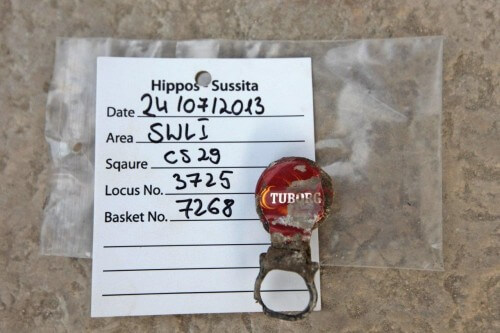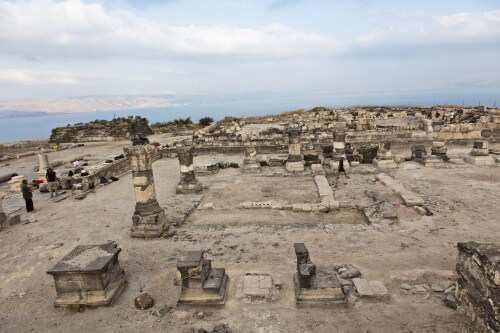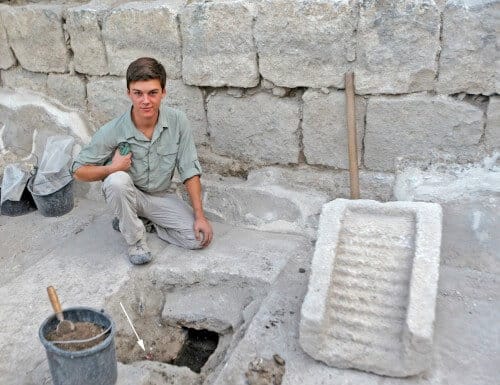"What is the probability that a tens-of-meter-long canal from the Roman period will be opened and a beer cork will be discovered?" said Dr. Michael Isenberg from the Zinman Institute of Archeology at the University of Haifa, the director of the excavation

Did the residents of Susita from 2000 years ago drink Toburg beer? A mysterious mystery awaited the archaeologists of the Institute of Archeology at the University of Haifa in the excavations of the ancient city of Susita: when they broke the Roman cement floor and exposed a drainage channel in the public bathhouse, the researchers found a beer cap from the "Toburg" company. "What is the probability that a tens-of-meter-long trench from the Roman period will be opened and a beer cork will be discovered?" said Dr. Michael Isenberg, the director of the excavation.
Even the 14th year of the University of Haifa's excavation in the ancient Roman city of Susita (Hipus), located east of the Sea of Galilee in the area of the Susita Nature Reserve and National Park of the Nature and Parks Authority, continues to provide impressive and surprising archaeological findings, which reveal additional layers of the life of the city founded in the second century BC and was destroyed in the great earthquake of 749.
As mentioned, the biggest surprise was provided by the public bathhouse that is being uncovered in the center of the southern cliff of Mount Susita, overlooking the Sea of Galilee and Tiberias on the other side. The season ended with the unveiling of the plaster - an incense square surrounded by columns where the city's youth exercised. During the excavations, the researchers uncovered the small swimming pool of the bathhouse (the "netatio"). The pool has been fully exposed, as it is paved with high-quality limestone tiles, limestone tiles decorate its walls and in other parts the pool plaster has been painted in bright red colors.

When the investigators noticed a repair patch on the pool floor, they immediately suspected that a drainage channel was hiding under the patch. After breaking through strong Roman cement, removing several cover plates and revealing a section of a drainage channel, a surprise awaited the researchers: a modern beer stopper. The Romans probably didn't drink the beer, but the real explanation is equally amazing: after about 2000 years, the drainage channel is apparently still active and the beer cork that entered through the open side reached almost to the other side. "We believe that the canal is still partially active and was used as a public toilet that has not yet been discovered, but must have been built above the bathhouse. Now we will try to trace the upper roof of the canal that fed the water and the cork and locate the toilet - the latrine - of the bathhouse," explained Dr. Isenberg.
Another unique find was discovered on the floor of the pool: a carved limestone with 10 small steps. "The diggers had fun thinking that this must be the first washing machine, but it seems that in front of us is a stone that was used as the end of the water slide that fed the pool. The flow of water on the stone created an audio-visual show that captivates the eye and ear," says Dr. Isenberg.
Other areas of the city also yielded fascinating findings. The Roman basilica - the commercial, economic and cultural area of the city, which covered an area of 55 by 30 meters - is in the advanced stages of exposure, but only this year did the excavators succeed in confirming what they previously suspected: under the remains of the Roman basilica, which was built at the end of the first century AD and destroyed in the earthquake of In 363, the remains of another public building were uncovered. "A series of five bases buried under the floor of the late basilica belong to a public building supported on columns. I estimate that this structure is another basilica that predates the one in front of us by about a hundred years. If we do prove this during the next season, we have before us one of the oldest basilica buildings in our area," said Dr. Isenberg. In addition, under the remains of the floors here, the remains of other even more ancient buildings were uncovered. "For the first time, we have solid material evidence of the early days of the city of Susita, with its original Greek name Antiochia Hippos, from the middle of the second century BC," he added.

The joint expedition from Concordia University, St. Paul in Minnesota, headed by Prof. Mark Schuler, continued this season in uncovering the northeastern structure. The results of the excavation here confirm the hypotheses of the researchers from the previous season in the residential quarter: Susita Nietzsche was gradually destroyed during the Umayyad period (at the end of the seventh-eighth century AD) even before the earthquake of 749, which destroyed the city. "We found blocked alleys and openings and evidence of an orderly evacuation of the residential buildings, all of which indicate a quiet departure and precisely here so close to the center of the city. "Susita slowly faded away, even before the earthquake destroyed it, until the archaeologists' efforts slowly wake it up from its slumber, revealing segment after segment of its secrets," concluded Dr. Isenberg.
The excavation enterprise in Susita, which as mentioned is in its 14th year, is an archaeological enterprise on a large scale and among the participants this year were researchers, volunteers and students from Israel and especially volunteers from many countries in the world. Since the site is to be opened as a site open to the public, the Susita delegation is investing enormous resources to carry out conservation work. This year, more than 15 conservationists worked in the field, with about a dozen students from the Department of Conservation Studies at the Western Galilee Academic College.

10 תגובות
The secret is probably confusion in the picture.
See here:
https://www.hayadan.org.il/venus-from-susita-2308091/
I would like to know what is the secret of Dr. Eisenberg's youth, who appears in the picture to be 17 years old, even though his age is closer to 40+
Just a friend sitting in the pool and drinking beer.
The cork is proof that the canal is artificial like all other archeology designed to serve the Zionist lie.
The Jews were never here, their history is fabricated
The main thing is to say that - "there never was a Palestinian people"
Anonymous (unidentified) user
When you grow up and drink Toburg, you will realize that it is their genius cork.....
It's a good idea that Stborg will be a sponsor and finance excavations in exchange for such information
A time traveler who is also an archeology enthusiast...it can only be Indiana Jones!
These are Toburg's corks. It sounds nice to come back in time to drink a beer in the pool and look out over the Sea of Galilee
Something weirder about this jam
It's a can cap and a bottle cap together, there's no such thing or it's a very old version of cans
These Toborgs…. What they won't do for cheap advertising…. kick them out!